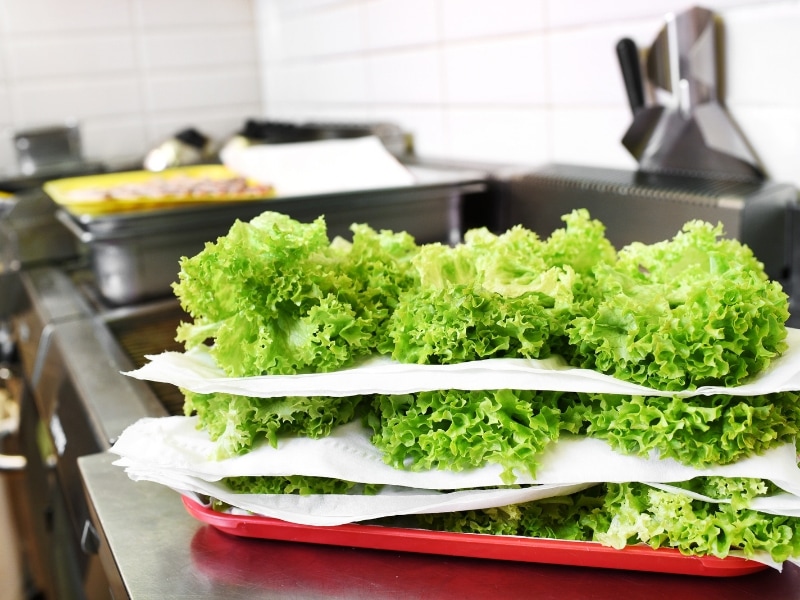Lettuce comes in several varieties, each with unique flavors and textures suitable for various dishes. For example, crispy romaine excels in Caesar salads due to its structure. Butterhead leaves offer a smooth, buttery taste popular in sandwiches. Crisphead resembles cabbage with bite. Green and red leaf varieties contribute mild sweetness to salads. Compact little gem is ideal for salads or garnishing. Bright coral lettuce maintains crispness with ruffled edges and mellow flavor. Overall, lettuce diversity allows creative applications based on desired qualities.
Nutrition
It offers various health advantages depending on the type. For instance, a single cup of romaine supplies 8 calories alongside high amounts of vitamin A, C and K. Moreover, butterhead contains 7 calories along with rich vitamin A, C, iron and calcium content. Likewise, red leaf lettuce delivers 4 calories per cup and boasts high vitamin A, C, iron and calcium levels. Additionally, while iceberg has 10 calories and slightly fewer micronutrients compared to others, it still contributes nutritional value.
What Are the Four Types of Lettuce?
Lettuce is categorized into four main types, each with unique textures and flavors:
1. Iceberg Lettuce
Known for its crisp texture and mild flavor.
Popular in burgers, sandwiches, and chopped salads.
Low in nutrients compared to other varieties but high in water content, making it hydrating.
2. Romaine Lettuce
Has long, sturdy leaves with a slightly bitter taste.
Higher in vitamins A, K, and folate than iceberg lettuce.
A key ingredient in Caesar salads due to its crunch and ability to hold dressings well.
3. Butterhead Lettuce (Bibb or Boston Lettuce)
Features soft, tender leaves with a slightly sweet taste.
Often used in wraps and delicate salads.
Rich in vitamin K, folate, and antioxidants.
4. Loose-Leaf Lettuce (Red Leaf & Green Leaf Lettuce)
Frilly, delicate leaves with a mild flavor.
Easy to grow at home and available in red and green varieties.
One of the most nutrient-dense lettuce types, packed with vitamins A, C, and K.
What Is the Best Lettuce to Eat?
The best lettuce depends on your nutritional goals and meal type:
For salads: Romaine, butterhead, or loose-leaf lettuce are the best choices.
For sandwiches & wraps: Iceberg or butterhead provide the perfect texture.
For nutrition: Loose-leaf and romaine lettuce have the highest vitamin content.
For weight loss: Romaine and green leaf lettuce are low in calories and high in fiber, making them ideal.
Best Lettuce for Meal Prep
Romaine and iceberg lettuce stay fresh longer.
Loose-leaf and butterhead are more delicate and should be eaten quickly.
Lettuce Benefits: Why You Should Eat More Lettuce
Lettuce is more than just a crunchy addition to meals—it’s packed with essential nutrients and offers several health benefits.
1. Rich in Vitamins and Antioxidants
High in vitamins A, C, and K, which support eye health, immunity, and blood clotting.
Contains beta-carotene and lutein, which promote healthy skin.
2. Supports Heart Health
Low in cholesterol and sodium, making it heart-friendly.
The potassium content in romaine and green leaf lettuce helps regulate blood pressure.
3. Promotes Better Digestion
The fiber content in lettuce helps prevent constipation and supports a healthy gut.
4. Keeps You Hydrated
Lettuce is 95% water, making it a great way to stay hydrated.
5. Low in Calories
Perfect for weight management since it’s low in calories and carbs.
Lettuce for Salad: The Best Varieties for a Fresh and Flavorful Dish
Not all lettuce works well in salads! Here’s the best lettuce for different types of salads:
Crunchy Salads: Romaine, iceberg
Soft & Buttery Salads: Butterhead lettuce
Nutrient-Dense Salads: Red leaf, green leaf
Mixed Green Salads: Combine multiple types of lettuce for texture and flavor balance
Lettuce Pairings for the Best Salads
For the best taste and nutrition, pair lettuce with:
Protein: Grilled chicken, tofu, chickpeas, or shrimp
Healthy Fats: Avocados, nuts, seeds, olive oil
Dressing: Light vinaigrettes or creamy yogurt-based dressings
Lettuce vs. Cabbage: What’s the Difference?
Which is Healthier?
Cabbage is richer in fiber and vitamin C, making it great for digestion and immunity.
Lettuce is lower in calories and water-rich, making it ideal for hydration and light meals.
Lettuce Benefits for Weight Loss
Lettuce is one of the best foods for weight loss due to its low-calorie, high-fiber, and water content.
Why Lettuce Helps with Weight Loss
Fills You Up Without Extra Calories
One cup of lettuce has less than 10 calories, making it great for low-calorie meals.
High Water Content
Helps you stay full longer and reduces cravings.
Boosts Metabolism
The vitamins and minerals in lettuce help maintain energy levels and digestion.
Easy to Add to Meals
Use it in salads, lettuce wraps, sandwiches, or smoothies to stay full and satisfied.
Best Lettuce for Weight Loss
Romaine lettuce – High in fiber and nutrients.
Green leaf lettuce – Packed with antioxidants and vitamins.
Butterhead lettuce – Low-calorie and soft for wraps and salads.
How To Store Lettuce
Proper storage is important to maintain lettuce freshness. To begin with, keep it dry, as moisture can cause lettuce to rot quickly. Furthermore, while an ideal place is a refrigerator’s crisper drawer, failing that, seek out a cool, dark location away from direct sunlight and heating appliances, like a pantry or basement.
What Goes Well With Lettuce
It complements herbs, spices, and sauces such as Dijon mustard, parsley, mint, chives, oregano, olive oil, balsamic/red wine vinegar, and various salad dressings. In addition, it goes well with a wide range of produce, including carrots, bell peppers, cucumbers, tomatoes, avocado, corn, beets, onions, and cabbage. Lettuce also pairs nicely with savory items such as eggs, prosciutto, nuts, seeds, pulses (like chickpeas), chicken, turkey, beef, pork, bacon, tofu, and fish. Furthermore, it can be combined with dairy products like feta, Parmesan, blue cheese, goat cheese, cheddar, mozzarella, and Swiss.

